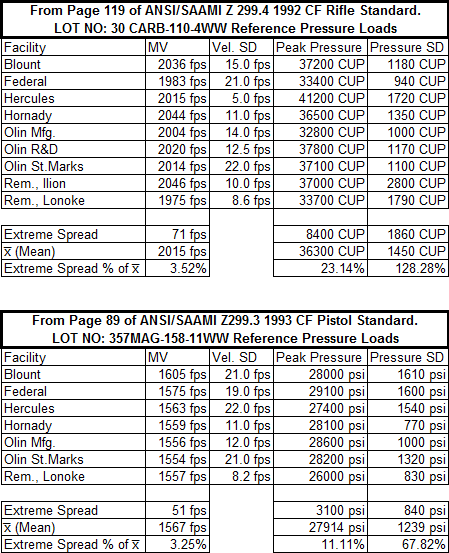We constantly discuss published loads that have (seemingly) been lowered across the board over years and the #1 knee-jerk claim is always that company liability lawyers have their hands all over every facet of every companies' life and that maximum loads have been lowered significantly over years.
I take issue with these assertions and it really makes me ask, "if the companies GENUINELY want us to load significantly more safely, shouldn't they completely remove some loads entirely in addition (or even instead of) simply lowering max loads?"
Easy one for me to use as an example is .44 Magnum.
If you build .44 Magnum loads with H110, you can make full bore, bigtime, hardcore .44 Magnum loads with all the possible performance one can get from a 240gr, .429" bullet. You will be maxing out on SAAMI allowable pressure and the case will be -FULL- of powder while doing so. And if you were to IGNORE the published max load and stuff more in there, the pressure would climb ever higher and you would begin to approach the hot PROOF LOADS that manufacturers put new gun through before shipping them.
However, if you build .44 Magnum loads with Titegroup... you will get (comparatively) lousy "performance" (if you equate velocity with performance) and you will be hitting SAAMI max pressure with less than HALF of the cartridge space being used. And if you elected to go over published max loads with Titegroup, you would see pressure spikes that come hard & fast with horrendous and dangerous results and if you were to foolishly cram as much Titegroup under the 240gr slug as you can fit H110, I don't think anyone has ever built a handgun that can contain the blast. At the very least, the gun is effectively destroyed.
If we use the argument that H110 max loads (or any max loads) have been lowered over time for our own good and our own safety...
...wouldn't it make sense that NOBODY -- powder manufacturers, bullet makers, manual authors, N O B O D Y would ever publish .44 Magnum loads for Titegroup?
For sure, you can make some quality .44 Mag loads with Titegroup! I have a 240gr LSWC Titegroup powered load that runs a consistent 870 fps that is excellent fun on steel plates without the usual beating of .44 Magnum at both ends of the gun.
But my point is that if you have a careless, ham-fisted, excitable reloader that is reckless at the load bench, he will NEVER impart the kind of damage to a .44 Magnum revolver with H110 than he could with Titegroup. Never will it happen.
Doesn't this dream team of company liability lawyers take this in to account?
Or is the liability lawyer talk just a concocted opinion for folks who -must- have a scapegoat that they never liked in the first place to blame things on?
I take issue with these assertions and it really makes me ask, "if the companies GENUINELY want us to load significantly more safely, shouldn't they completely remove some loads entirely in addition (or even instead of) simply lowering max loads?"
Easy one for me to use as an example is .44 Magnum.
If you build .44 Magnum loads with H110, you can make full bore, bigtime, hardcore .44 Magnum loads with all the possible performance one can get from a 240gr, .429" bullet. You will be maxing out on SAAMI allowable pressure and the case will be -FULL- of powder while doing so. And if you were to IGNORE the published max load and stuff more in there, the pressure would climb ever higher and you would begin to approach the hot PROOF LOADS that manufacturers put new gun through before shipping them.
However, if you build .44 Magnum loads with Titegroup... you will get (comparatively) lousy "performance" (if you equate velocity with performance) and you will be hitting SAAMI max pressure with less than HALF of the cartridge space being used. And if you elected to go over published max loads with Titegroup, you would see pressure spikes that come hard & fast with horrendous and dangerous results and if you were to foolishly cram as much Titegroup under the 240gr slug as you can fit H110, I don't think anyone has ever built a handgun that can contain the blast. At the very least, the gun is effectively destroyed.
If we use the argument that H110 max loads (or any max loads) have been lowered over time for our own good and our own safety...
...wouldn't it make sense that NOBODY -- powder manufacturers, bullet makers, manual authors, N O B O D Y would ever publish .44 Magnum loads for Titegroup?
For sure, you can make some quality .44 Mag loads with Titegroup! I have a 240gr LSWC Titegroup powered load that runs a consistent 870 fps that is excellent fun on steel plates without the usual beating of .44 Magnum at both ends of the gun.
But my point is that if you have a careless, ham-fisted, excitable reloader that is reckless at the load bench, he will NEVER impart the kind of damage to a .44 Magnum revolver with H110 than he could with Titegroup. Never will it happen.
Doesn't this dream team of company liability lawyers take this in to account?
Or is the liability lawyer talk just a concocted opinion for folks who -must- have a scapegoat that they never liked in the first place to blame things on?

